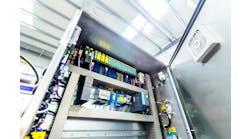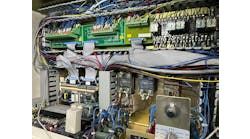Industrial electrical enclosures require a variety of considerations when designing and implementing them. Let’s delve into safety and compliance. You might argue that human Safety is of more importance, but the regulations surrounding the application of industrial enclosures has this well covered. Here we need to ensure that the enclosure design complies with relevant industry standards and safety regulations.
Additionally, in terms of safety, labelling is very important. Clearly label the enclosure with important information, including safety warnings, voltage ratings and compliance certifications.
Get your subscription to Control Design’s daily newsletter.
Most enclosures have cable connections, and these require careful cable management. Cable entry/exit points need to be planned to maintain a tidy and secure internal layout. Additionally, the use of sealed cable glands will maintain the enclosure's environmental protection while allowing for the passage of cables.
Then the significance of security means locking mechanisms chosen to prevent unauthorized access to the enclosure. One can even go so far as to install additional security features such as tamper-evident seals or alarm systems. One needs to ensure that no unauthorized person is able to gain access or make adjustments to sensitive plant equipment.
To further ensure professionalism in design selection the aspects of size and space require consideration: First, there needs to be adequate space for the equipment it houses, allowing for proper ventilation and maintenance. Then, the aspect of future expansion—plan for potential future expansions or additions to the system.
In this respect, it is wise to allow for an additional 10% or even 20% additional terminals, but, naturally, it simply depends on the likelihood of there being extra requirements.
In most cases, as additional enclosure will be used, so this fact alone negates the need for expansion. However, if this is a large, central enclosure, housing all the equipment in a certain area, then quite naturally it will be necessary to allow for future expansion.
On one mining site in Madagascar, the client’s design engineering consultants forgot a whole series of additional items on their reactors and the local PLC cabinets were not able to accommodate the necessary additions. This caused serious contract delays.
By addressing these considerations, designers can create industrial enclosures and cabinets that offer robust protection, reliable performance and ease of maintenance in demanding industrial environments.
Industry is equipped with extremely objective ratings for protection of equipment installed in enclosures. Here are the two main specification sheets.
NEMA ratings for industrial enclosures
Selection of appropriate rating: Choose enclosures that comply with National Electrical Manufacturers Association (NEMA) standards or IP ratings appropriate for the specific environmental conditions. NEMA Type 12 and Type 4X enclosures, for example, are designed to protect against dust and other contaminants.
- NEMA 1: General purpose indoor, prevents accidental contact of personnel with the enclosed equipment
- NEMA 3R: Windblown dust, vertical rain, severe external corrosion
- NEMA 4: Dust, watertight, splashing rain, hose directed water, severe external condensation
- NEMA 4X: Dust, rain, splashing rain, hose directed water, ice, corrosion resistant
- NEMA 12: Indoor, dust, falling dirt, dripping non-corrosive material
- NEMA 7: Withstands the pressure from an internal explosion from the specified gas ignited.
IP ratings: Electrotechnical Commission (IEC) describes the degree to which industrial enclosures provide protection against the ingress of foreign objects and moisture. There are six IP ratings that describe protection against foreign objects and vary from >50 mm particle protection to completely dust-tight protection. There are eight IP ratings for protection against moisture which vary from dripping water protection to protection when completely submersed. IP scores are given in xx combinations, where the first x is the protection against solid objects and the second x is protection against liquids.





